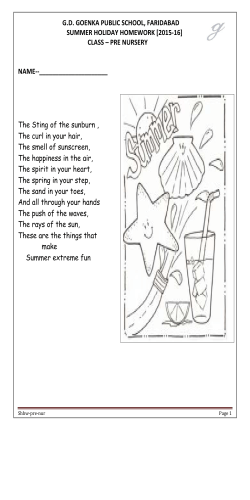
Changes in fruit colour of Dusehari mangoes during ethephon
International Journal of Agriculture, Environment and Biotechnology Citation: IJAEB: 8(1): 97-101 March 2015 DOI Number: 10.5958/2230-732X.2015.00013.3 ©2015 New Delhi Publishers. All rights reserved 12 HORTICULTURE Changes in fruit colour of Dusehari mangoes during ethephon induced ripening Parmpal Singh Gill*, Sukhjit Kaur Jawandha, Navdeep Kaur and Annu Verma Department of Fruit Science, Punjab Agricultural University, Ludhiana. Punjab, India. *Corresponding author: parmpalgill@pau.edu Paper No. 297 Received: 19 November 2014 Accepted: 2 March 2015 Published: 25 March 2015 ABSTRACT The effect of ethephon on colour changes of Dusehari mango (Mangifera indica) fruits during ripening was examined. Physiological mature fruits were given post harvest dip of ethephon solution @ 0, 200, 400, 600, 800 and 1000 ppm for five minutes. Treated fruits were packed in CFB boxes placed at ambient conditions for ripening. Fruit peel and pulp colour was determined after 48, 72, 96, 120 and 144 h after ripening treatments using Hunter Lab scale. Results revealed that all ethephon treatments enhanced colour development as compared to control. The luminosity of peel increased with increase in concentration of ethephon as well as with ripening period. The greenness of peel as reflected by ‘a’ values decreased with ripening treatments and period. However ‘a’ value for pulp increased with development of redness of tissue. The fruit peel developed yellowish colour with ethephon treatments as evidenced by increase in values of ‘b’. The effect of ethephon on colour changes at higher doses (800 ppm and 1000 ppm) was non-significant after 120 h of ripening period. Highlights • Ethephon treatments @ ≥400 ppm accelerated peel and pulp colour changes in Dusehari mangoes during ripening under ambient conditions. Keywords: Mango, ethephon, ripening, Hunter Lab, colour development Mango is the most important fruit grown from tropical to sub-tropical regions of India. In northern region of country, Dusehari is leading cultivar due to high yield potential and good fruit quality. The fruit of mango is harvested at hard green stage after physiological maturity is attained. In developing countries like India fruits are commonly subjected to artificial ripening by the use of low-cost calcium carbide (Rahman et al., 2008) that decomposes to acetylene and results in poor flavour. Ripening of fruits with calcium carbide is banned under Prevention of Food Adulteration (PFA) act. However, on tree under natural conditions, ripening of mango fruit is very slow and heterogeneous. Ethephon has been used widely to hasten ripening of apples, cherries, blueberries figs, pineapple, peaches, guava, grapes, citrus and walnut (Watada 1986, Abeles et al., 1992). In mangoes ethylene enhances the ripening process and improves the peel colour. After subjected to ripening treatments, the breakdown of green colour of mango fruits occurs with ripening. The ripening level is critical for the development of ideal flavor quality of mango fruit. In Dusehari cultivar visual colour is important factor which determines consumer acceptability. For predicting the internal flesh color of ‘Kensington Pride’ and ‘Calypso’ mangoes Subedi et al., (2007) evaluated the potential use of a handheld spectrophotometer. Internal fruit Gill et.al. quality characteristics of mango are correlated with the colour values and can be predicted satisfactorily (Jha et al., 2006). Richard Hunter used Hunter L, a, b system for measuring ripeness of food commodities including mango (Slaughter, 2009). The present studies were conducted to examine the efficacy of different doses of ethephon as post harvest dip on fruit colour development of Dusehari mango during ripening under ambient conditions. HSD procedure was used to discriminate among means at significance level of p<0.05. Results and Discussion Changes in ‘L’ values of peel Changes in the peel pigments during the maturing process determine the colour of the fruit (Bejo and Kamaruddin, 2014). Different post harvest ethephon treatments significantly affected the luminosity (L) of mango peel (Table 1). The L value increased with ripening of fruit induced by ethephon treatments as well as with ripening period. The mean maximum ‘L’ value of mango peel was noted in fruits treated with 1000 ppm ethephon followed by 800 ppm ethephon treatment. The mean minimum peel brightness was observed in control fruits which was significantly lower as compared to all other treatments except ethephon 200 ppm treatment. Similarly, the peel luminosity significantly increased from 48 to 120 h of treatments at ambient conditions and afterward a non significant decrease in luminosity was noted at the end of studies. The mean maximum per cent increase in radiance of peel (4.98) was recorded from 48 to 72 h of treatments. The interactions between ethephon treatments and ripening period were found to be significant. The lowest L value (38.2) was recorded in control fruits after 48 h of treatments while the highest (50.0) was observed with 1000 ppm ethephon after 120 h of treatments. The differences in L values were non-significant from 96 to 144 h after ripening treatments in higher doses (600 to 1000 ppm) of ethephon treatments. The increase in lightness of skin with ethephon treatments and advancement of ripening time may be attributed to loss of dark green colour of the fruits. Exposure to ethylene increased color, producing high-quality fruit in a shorter time (Kato, 1990. Materials and Methods The study was carried out during the year 2013 at Post Harvest Laboratory, Department of Fruit Science, Punjab Agricultural University, Ludhiana. Uniform sized and physiologically mature fruits of mango cv. Dusehari were harvested from commercial bearing mango orchard during the morning hours. The fruits were hand picked with long stem, and subsequently desapping was done. The fruits were dipped in aqueous solution of ethephon (SRL – 40 % aqueous solution) @ 0, 200, 400, 600, 800 and 1000 ppm for five minutes. After drying fruits were packed in corrugated fibre board boxes using paper cushioning material and kept under ambient conditions (33 ± 2oC and 50 ± 20 % RH) for 6 days. The fruit colour development was recorded after 48, 72, 96, 120 and 144 h after ripening treatments. The peel and pulp colour was measured by using Hunter Lab scale (model ColorFlex, Reston, USA), with reflectance mode (Hunter, 1975). Before taking down observation the instrument was calibrated with a standard white ceramic tile and black tile and set up for D65 as illuminate and a 10º observer angle. Sampling was carried out by loading the quartz cuvettes with fruit peel and pulp sample. The colour was determined using L, a, b colour system, where L indicate luminosity or lightness (L = 0 for black and L = 100 for white), positive a indicate measure of red; negative a indicate green while, b represent blue (-) to yellow (+) space. The data were statistically analyzed to a completely randomized experimental design by two-way (factors; ethephon treatments and ripening period) ANOVA with PROC GLM procedure using SAS software version 9.3 (SAS Institute Inc., Cary, NC, USA). Subsequently Tukeys’ Changes in ‘b’ values of peel The yellowness of peel indicated by ‘b’ values for fruit peel colour was significantly affected by various ethephon treatments. The presence of yellowness on peel increased with ripening treatments as indicated by higher ‘b’ values (Table 1). Mean maximum 98 Changes in fruit colour of dusehari mangoes during ethephon induced ripening Table 1. Effect of ethephon treatments on fruit peel ‘L’ and ‘b’ values during ripening at ambient conditions. Treatment Ethephon 200 ppm Peel ‛L’ Ripening period 96 h 120 h 144 h 48h 72 h Mean 42.3b40.2f-g 41.6e-g 45.0a-f 45.8a-f 43.0cd g 16.8k Mean 26.6c Ethephon 400 ppm 42.7dg 17.70jk 19.8j 31.1e-f 35.3b-c 36.2b 28.0b Ethephon 600 ppm 43.4b44.5a-f 47.3a-e 47.9a-d 47.0a-e 46.0ab 17.9j-k g 19.7j 30.9f-g 35.3b-c 35.9b 28.0b Ethephon 800 ppm 43.2c-g 46.9a-e 49.0a-c 49.1a-b 45.4a-f 46.7a 18.7j-k 23.8i 32.7d-f 39.0a 38.7a 30.6a Ethephon 1000 ppm 44.7a-f 47.1a-e 47.3a-e 47.8a 18.3j-k 23.4i 34.8bd 38.8a 38.9a 30.9a 41.9e-g 40.1f-g 44.9a-f 45.1a-f 42.0d 16.9k 17.8j-k 28.7h 17.7e 20.5d 31.2c Control 38.2g Mean 42.1c 42.9d42.8d45.5a-f 46.8a-e g g 48h Peel ‛b’ Ripening period 72 h 96 h 120 h 144 h 28.9g18.5j-k 33.2c-e 35.7d-f h 44.3b 49.9a 45.6ab 50.0a 47.3a 44.1bc 45.6ab 31.8e-f 34.3b-d 35.6b 25.9c 36.6a Table 2. Effect of ethephon treatments on fruit peel and pulp ‘a’ values during ripening at ambient conditions. Treatment Ethephon 200 ppm Peel ‘a’ Ripening period 48h 72 h 96 h 120 h 144 h Mean -8.95a- -7.86c- -7.64c- -7.01e-9.82a -8.26b c e f i 48h 9.4mn 72 h 12.9jm Pulp ‛a’ Ripening period 96 h 120 h 144 h 20.8fg 27.2a-e 28.3a-c Mean 19.7c -8.63a- -7.52d- -7.41d- -6.21g-7.88bc 10.8l-n 14.8i-k 23.6e-f 28.0a-d 27.5a-d 20.9bc d g h k Ethephon 400 ppm -9.63a Ethephon 600 ppm -9.32a- -8.52a- -7.41d- -7.40d- -5.99ib d h h k -7.73c 11.1k-n 15.4hj 24.4d-f 28.8a-b 27.2a-e 21.4b Ethephon 800 ppm -8.70a- -7.58d- -7.50d- -6.08h- -6.01id f g k k -7.17d 13.7j-l 18.7g24.8c-e h 29.8a-b 23.5a -6.51e 13.3j-l 20.9fg 26.2b-e 29.2a-b 28.9a-b 23.7a 10.7l-n 18.3g-i 26.3be 27.5a-d 18.2d Ethephon ppm 1000 -8.51a- -7.52d-5.12j-6.42f-j d g k -5.00k Control -9.82a -9.41a -8.67a- -8.01b- -7.75c-8.73a d e f 8.3n Mean -9.30a -8.44b -7.56c 11.1d -6.94d -6.33e development of yellowish colour was recorded with highest dose of ethephon which was at par ethephon 800 ppm treatment. The control fruit recorded minimum development of yellow colour and it was closely followed by ethephon 200 ppm treatment. Significant increase in ‘b’ values was observed with ripening period. However, maximum mean percent yellow colour development was noted from 72 to 96 h of treatments. This could be due to higher rate 15.6c 23.0b 30.4a 28.3a 28.2a of ripening during this period. In bananas ethylene stimulates chlorophyll loss and the appearance of yellow color (Saltveit, 1999). The interaction between various treatments and ripening period were also significant. The ‘b’ value ranges from 16.9 in control fruits at initial interval to 38.9 in ethephon 1000 ppm treatment after 144 h of treatments. After 48 h of storage the ‘b’ value were not statistically different among various treatments. However after 72 h of 99 Gill et.al. storage, 800 and 1000 ppm dose recorded significantly higher ‘b’ values as compared to rest of treatments indicating higher development of yellow colour in these treatments. No change in ‘b’ coordinates was noted from 120 to 144 h of treatments all the ripening treatments, except for ethephon 200 ppm and control treatment. while ‘L’ and ‘b’ values of pulp showed inconsistent trend and are not presented in this paper. Various ethephon treatments increased redness of pulp as compared to control. Ethephon 1000 ppm recorded mean maximum ‘a’ value followed by ethephon 800 ppm treatment. Similarly, redness of pulp colour increased significantly from 48 h to 120 h of ripening. Interaction between treatments and ripening period was also significant. The intensity of red colour increased from 8.3 in control (48 h after treatments) to 30.4 in 800 ppm treated fruits (120 h after treatments). The ‘a’ values increased significantly from 48 h to 120 h after ripening period in ethephon 400, 600 and 1000 ppm treatments. Similarly the value of ‘a’ was statistically at par from 120 h to 144 h of ripening period in all the treatments suggesting no further development of pulp colour after 120 h of ripening period. The maximum pulp colour development was noticed from 48 to 96 h of ripening in ethephon doses greater than 400 ppm, while in control the colour change was noticed up to 144 h of treatments. The decrease in ‘a’ values after 144 h of ripening treatments could be due to breakdown of fruit tissue as a consequence of over-ripening in ethephon treatments. Earlier studies shown that colour of mango fruits increased significantly with ethephon treatments which may be attributed to higher level of carotenoids, synthesis of other pigments, and degradation of chlorophyll, due to ethephon treatments (Singh and Janes, 2001). Changes in ‘a’ values of peel The decrease in ‘a’ value with ethephon treatments represent the gradual loss of greenness of fruit peel. The mean intensity of peel green colour was significantly decreased with ethephon treatments. Control fruits retained mean maximum value (-8.73) of ‘a’ while maximum loss of green colour (-6.51) was noted in ethephon 1000 ppm treatment (Table 2). In ‘Keitt’ mangoes the fruit colour changed from green to red as concentration of ethephon increased from 0 to 2000 ppm as post harvest dip (Sergent et al., 1993). Similarly the mean values of ‘a’ decreased significantly with advancement of ripening period and mean minimum ‘a’ value (-6.33) was noted at the end of ripening period. However, percent loss of green colour was higher at initial ripening interval as compared to end of experiment. The interaction between ethephon treatment and ripening were also significant. Maximum greenness of peel (-9.82) was recorded in control fruits and ethephon 200 ppm treatment. After 72 h of treatments, significant degradation of green colour at 800 and 1000 ppm treatments but at lower doses of ethephon difference was non-significant. This may be to slower onset of ripening changes in control and lower doses of ethephon treatments. The maximum loss of greenness of peel was noted in highest dose of ethephon after 144 h of trial. The decrease in ‘a’ values with ethephon treatment became non significant after 120h of ripening period, except for ethephon 600 ppm treatment. Similar development of colour in Tommy Atkin mangoes with ethephon treatment was reported by Centurion Yah, (1998). Acknowledgments The authors are thankful to UGC-New Delhi for providing financial assistance to carry out the experiment. References Abeles FB, Morgan PW, Saltveit ME (1992) Ethylene in Plant Biology 15(2). Academic Press, San Diego, California. doi. org/10.1016/b978-0-08-091628-6.50002-3 Bejo SK, Kamaruddin S (2014) Determination of Chokanan mango sweetness (Mangifera indica) using non-destructive image processing technique. Australian J Crop Sci 8:475-480. Changes in ‘a’ values of pulp Centurion Yah AR, Gonzalez Novelo SA, Tamayo Cortes JA, Argumedo JJ, Sauri Duch E (1998) Significant changes in ‘a’ values were recorded in fruit pulp colour which are presented in Table 2 100 Changes in fruit colour of dusehari mangoes during ethephon induced ripening The effect of Ethephon on the colour, composition and quality of mango (Mangifera indica, cv Kent) Food Sci and Technol Internat 4: 199-205. doi. org/10.1177/108201329800400306 Hunter S (1975) The Measurement of Appearance. 304-305. John Wiley and Sons. New York. Jha SN, Kingsly ARP, Chopra S (2006) Physical and mechanical properties of mango during growth and storage for determination of maturity. Journal of Food Engineering 72:73–76. doi.org/10.1016/j.jfoodeng.2004.11.020 Kato K (1990) Astringency removal and ripening in persimmons treated with ethanol and ethylene. HortScience 25:207. Rahman A, Chowdhury FR, Alam MB (2008) Artificial ripening: what we are eating. Journal of Medicine 9:42-44. doi.org/10.3329/jom.v9i1.1425 Saltveit ME (1999) Effect of ethylene on quality of fresh fruits and vegetables. Postharvest Biology and Technology 15:279292. doi.org/10.1016/s0925-5214(98)00091-x Sergent E, Schaffer B, Lara SP, Wills LE (1993) Effect of ethephon on mango (Mangifera Indica L) fruit quality. Acta Horticulture 341:510-517. Singh Z and Janes J (2001) Effect of postharvest application of ethephon on fruit ripening, quality and shelf life of mango under modified atmosphere packaging. Acta Horticulturae 553: 599-602. Slaughter DC (2009) Nondestructive maturity assessment methods for mango: A review of literature and identification of future research needs. National Mango Board, Orlando, FL, USA. Subedi PP, Walsh KB, Owens G (2007) Prediction of mango eating quality at harvest using short-wave near infrared spectrometry. Postharvest Biology and Technology 43:326334. doi.org/10.1016/j.postharvbio.2006.09.012 Watada AE (1986) Effects of ethylene on the quality of fruits and vegetables. Food Technology 40: 82–85. 101
© Copyright 2025









